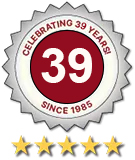Calculate the SCFM.
Temperature Sensors
Thermocouple Wire Calibration Type Characteristics
Calibration Type Characteristics
Type T (COPPER vs CONSTANTAN) is used for service in vacuum, oxidizing, inert or reducing atmospheres. It is highly resistant to corrosion from atmospheric moisture and condensation and exhibits high stability at low temperatures; it is the only type with limits of error guaranteed for cryogenic temperatures.
Type J (IRON vs CONSTANTAN) is used protected or unprotected in vacuum, oxidizing, inert or reducing atmospheres. Iron element oxidizes rapidly at temperatures exceeding 1000°F, and therefore heavier gauge wire is recommended for longer life at these temperatures.
Type E (CHROMEL vs CONSTANTAN) may be used protected, or unprotected in oxidizing, inert or dry reducing atmospheres or for short periods of time under vacuum. Must be protected from sulfurous and marginally oxidizing atmospheres. Produces the highest EMF per degree of any standardized thermocouple.
Type K (CHROMEL™ vs ALUMEL™) is used protected or exposed in oxidizing, inert or dry reducing atmospheres. Exposure to vacuum limited to short time periods. Must be protected from sulfurous atmospheres and marginally oxidizing atmospheres. Reliable and accurate at high temperatures.
Type N (NICROSIL vs NISIL) is used protected or exposed in oxidizing, inert or dry reducing atmospheres. Must be protected from sulfurous atmospheres. Very reliable and accurate at high temperatures.
Type S (PLATINUM-10%, RHODIUM vs PLATINUM)
Type R (PLATINUM-13%, RHODIUM vs PLATINUM)
Type B (PLATINUM-30%, RHODIUM vs PLATINUM- 6% RHODIUM)
Platinum alloy thermocouples are all recommended for use in inert or oxidizing atmospheres, or for short periods of time in a vacuum. Easily contaminated, these elements must be protected from the effects of reducing atmospheres and contaminating vapors. Alumina protection tubes are recommended for directly containing platinum element.
Type WR† (TUNGSTEN vs TUNGSTEN 26% RHENIUM)
Type W3† (TUNGSTEN 3% RHENIUM vs TUNGSTEN 26% RHENIUM
Type W5† (TUNGSTEN 5% RHENIUM vs TUNGSTEN 26% RHENIUM)
Tungsten alloy thermocouples are all recommended for use in vacuum, high purity hydrogen, or high purity inert atmospheres. Very poor oxidation resistance. Pure tungsten is inherently brittle. W3 and W5 offer the advantage of ductility for ease of handling.
† Not ANSI Symbols
Thermocouple Insulation
Provides electrical insulation for thermocouple and thermocouple extension wire. If the insulation breaks down for any reason, the indicated temperature may be in error. When selecting insulation, moisture, abrasion, flexing, chemical attack, temperature extremes and any other adverse environmental considerations must be evaluated. Insulations are rated for a maximum continuous use temperature and also a maximum single exposure temperature because after excessive temperatures have been encountered the insulation may become conductive or conductive residues may form even though the insulation remains physically intact. Also do not assume the temperature rating as the temperature at the sensing junction of the thermocouple without evaluating the thermocouple system.
Fibrous Insulation
Fibrous Insulation is either braided or carded on the conductors. In general, fibrous insulations are used for applications where extreme moisture and abrasion resistance requirements are not prevalent. Available at moderate cost for upper utilization temperatures of 900° F (482°C) for fiberglass, 1800° F (982°C) for high temperature silica fiber, and 2200° F (1204°C) for ceramic fiber.
Plastic Insulation
Plastic Insulation is used in comparatively low temperature applications and provides good moisture and abrasion resistance. Available at low to moderate cost with typical upper utilization temperature of 220° F (104°C) for PVC and 500° F (260°C) for teflon.
Wiring Electronic Instruments
Wiring Electronic Instruments to conform to national and local codes does not address the “noise” problems of electronic instruments. Shielding of thermocouple and thermocouple extension wire may be necessary but not the only requirement of reducing noise. Ever since the introduction of electronics into instruments, noise generated by external relays, switches, motors, phase fired thyristors, etc. have caused problems that interfere with the instrument’s operation. Now that microprocessors are being increasingly incorporated into many more varied instruments, external sources that generate noise pulses that, in some cases, may render the instrument completely inoperative, have become crucial to instrumental applications. While much can be done within the instrument to reduce its sensitivity to external noise, the solution in many cases can only be resolved by suppressing the noise generation at its source.
Accuracy of Convectronics Wire
Convectronics’ insulated and bare thermocouple wire is matched to meet standard initial calibration tolerances for temperatures above 0°C as given in ANSI MC96.1. Wire conforming to special initial calibration tolerances, wire for use at sub-zero temperatures, and wire with certified traceable calibration is available on request. Designate special limit grade wire by adding a -SP suffix (e.g. K-SP, J-SP). Sub-zero and calibration requirements should be spelled out on the Purchase Order.
| INITIAL CALIBRATION TOLERANCES FOR THERMOCOUPLE WIRE | |||||||
|---|---|---|---|---|---|---|---|
| Thermocouple Type | °C | °F | |||||
| Wire Alloys | ANSI Type Symbol | Temperature Range |
Standard Limits | Special Limits |
Temperature Range |
Standard Limits |
Special Limits |
| Copper (+) vs. Constantan (-) |
T | -200° to -65° | ±1.5% | ±.8% | -330° to -85° | ±1.5% | ±.8% |
| -65° to +130° | ±1° | ±.5° | -85° to +270° | ±1.8° | ±.9° | ||
| +130° to +350° | ±.75% | ±.4% | +270° to +660° | ±.75% | ±.4% | ||
| *Iron (+) vs. Constantan (-) |
J | 0° to +285° | ±2.2° | ±1.1° | +32° to +545° | ±4° | ±2° |
| +285° to +750° | ±.75% | ±.4% | +545° to +1400° | ±.75% | ±.4% | ||
| Chromel™(+) vs. Constantan (-) |
E | -200° to -170° | ±1% | ±1° | -330° to -270° | ±1% | ±1.8° |
| -170° to +250° | ±1.7° | ±1° | -270° to +480° | ±3° | ±1.8° | ||
| +250° to +340° | ±1.7° | ±.4% | +480° to +640° | ±3° | ±.4% | ||
| +340° to +900° | ±.5% | ±.4% | +640° to +1600° | ±.5% | ±.4% | ||
| Chromel™(+) vs. *Alumel™(-) |
K | -200° to -110° | ±2% | -330° to -165° | ±2% | ||
| -110° to 0° | ±2.2° | -165° to +32° | ±4° | ||||
| 0° to +285° | ±2.2° | ±1.1° | +32° to +545° | ±4° | ±2° | ||
| +285° to +1250° | ±.75% | ±.4% | +545° to +2300° | ±.75% | ±.4% | ||
| Nicrosil (+) vs. Nisil (-) |
N | 0° to +285° | ±2.2° | ±1.1° | +32° to +545° | ±4° | ±2° |
| +285° to +1250° | ±.75% | ±.4% | +545° to +2300° | ±.75% | ±.4% | ||
| Platinum - 10% Rhodium (+) vs. Platinum (-) |
S | 0° to +600° | ±1.5° | ±.6° | +32° to +1110° | ±2.7° | ±1.1° |
| +600° to +1450° | ±.25% | ±.1% | +1110° to +2650° | ±.25% | ±.1% | ||
| Platinum - 13% Rhodium (+) vs. Platinum (-) |
R | 0° to +600° | ±1.5° | ±.6° | +32° to +1110° | ±2.7° | ±1.1° |
| +600° to +1450° | ±.25% | ±.1% | +1110° to +2650° | ±.25% | ±.1% | ||
| Platinum - 30% Rhodium (+) vs. Platinum -6% Rhodium (-) |
B | +870° to +1700° | ±.5% | ±.25% | +1600° to +3100° | ±.5% | ±.25% |
| Tungsten (+) vs. Tungsten -26% Rhenium (-) |
WR† | +400° to +2300° | ±1% | +800° to +4200° | ±1% | ||
| Tungsten -3% Rhenium (+) vs. Tungsten -25% Rhenium (-) |
W3† | +400° to +2300° | ±1% | +800° to +4200° | ±1% | ||
| Tungsten -5% Rhenium (+) vs. Tungsten -26% Rhenium (-) |
W5† | +400° to +2300° | ±1% | +800° to +4200° | ±1% | ||
| *Magnetic ™Trademark, Hoskins Mfg. Co. † NOT ANSI Type Symbol |
NOTE - Percent limits apply directly to temperatures in °C units, but for °F equivalents are applied to the number of °F above or below the ice point (+32°F) (i.e., limit (°F) = (temp.°F-32°) x Percentage) | ||||||
Thermocouple Extension Wire
Thermocouple extension wire has approximately the same thermoelectric characteristics as the thermocouple wire but its accuracy is guaranteed over a more limited range of temperature. Thermocouple extension wire can offer advantages in cost or mechanical properties when used for connections between thermocouples and instruments. For base metal types of thermocouples, extension wire is of substantially the same composition as the corresponding thermocouple type. For noble metal types, however, an entirely different alloy is formulated to match the noble metal characteristics over a specified temperature range. This is necessary due to the high cost of the noble metals which could otherwise be necessary for the interconnection. The “X” in the ANSI code denotes extension grade wire.
| INITIAL CALIBRATION TOLERANCES FOR THERMOCOUPLE WIRE | |||||||
|---|---|---|---|---|---|---|---|
| Thermocouple Type | °C | °F | |||||
| Extension Wire Alloys | ANSI Type Symbol | Temperature Range |
Standard Limits | Special Limits |
Temperature Range |
Standard Limits |
Special Limits |
| Copper (+) vs. Constantan | TX | -60° to +100 ° | ±1° | ±5° | -75° to +210 ° | ±2° | ±1° |
| *Iron vs. Constantan | JX | 0° to +200° | ±2.2° | ±1.1° | +32° to +400° | ±4° | ±2° |
| Chromel™ vs. Constantan | EX | 0° to +200° | ±1.7° | ±1.1° | +32° to +400° | ±3° | ±2° |
| Chromel™ vs. *Alumel™ | KX | 0° to +200° | ±2.2° | ±1.1° | +32° to +400° | ±4° | ±2° |
| Nicrosil vs. Nisil | NX | 0° to +200° | ±2.2° | ±1.1° | +32° to +400° | ±4° | ±2° |
| Copper vs. Copper Alloy | SX | +25° to +200° | ±7° | +75° to +400° | ±12° | ||
| RX | |||||||
| PLCW630 vs. Copper | BX | 0° to +200° | ±2.2° | +32° to +400° | ±4° | ||
| Copper vs. Copper | BX | 0° to +65° | ±1° | +32° to +150° | ±2° | ||
| Alloy 203 vs. Alloy 225 | W3X† | 0° to +260° | ±7° | +32° to +500° | ±12° | ||
| Alloy 405 vs. Alloy 426 | W5X† | 0° to +870° | ±7° | +32° to +1600° | ±12° | ||
| *Magnetic | ™Trademark, Hoskins Mfg. Co. | † NOT ANSI Type Symbol | |||||



